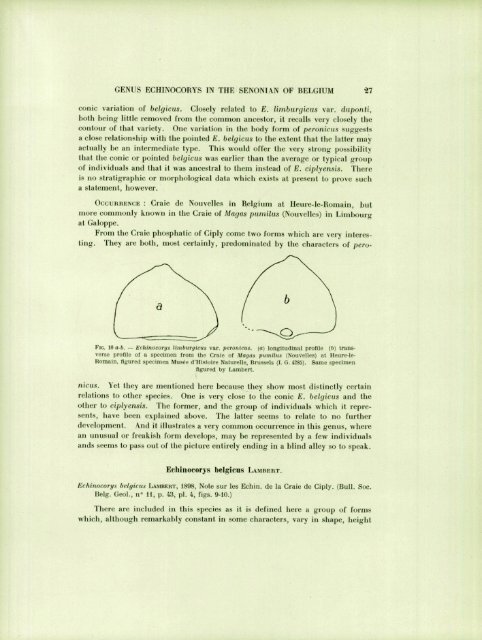ECIIINOID GENUS ECHINOCOIÎYS
ECIIINOID GENUS ECHINOCOIÎYS
ECIIINOID GENUS ECHINOCOIÎYS
You also want an ePaper? Increase the reach of your titles
YUMPU automatically turns print PDFs into web optimized ePapers that Google loves.
<strong>GENUS</strong> ECHINOCORYS IN THE SENONIAN OF BELGIUM 27<br />
conic variation of belgicus. Closely related to E. limburgicus var. duponti,<br />
both being little removed from the common ancestor, it recalls very closely the<br />
contour of that variety. One variation in the body form of peronicus suggests<br />
a close relationship with the pointed E. belgicus to the extent that the latter may<br />
actually be an intermediate type. This would offer the very strong possibility<br />
that the conic or pointed belgicus was earlier than the average or typical group<br />
of individuals and that it was ancestral to them instead of E. ciplyensis. There<br />
is no stratigraphic or morphological data which exists at present to prove such<br />
a statement, however.<br />
OCCURRENCE : Craie de Nouvelles in Belgium at Heure-le-Romain, but<br />
more commonly known in the Craie of Magus pumilus (Nouvelles) in Limbourg<br />
at Galoppc.<br />
From the Craie phosphatic of Ciply come two forms which are very interesting.<br />
They are both, most certainly, predominated by the characters of pero-<br />
Fic. 10a-6. - Echinocorys limburgicus var. peronicus. (a) longitudinal profile (6) transverse<br />
profile of a specimen from the Craie of Magas pumilus (Nouvelles) at Heure-le-<br />
Romain, figured specimen Musée d'Histoire Naturelle, Brussels (I. G. 4285). Same specimen<br />
figured by Lambert.<br />
nicus. Yet they are mentioned here because they show most distinctly certain<br />
relations to other species. One is very close to the conic E. belgicus and the<br />
other to ciplyensis. The former, and the group of individuals which it represents,<br />
have been explained above. The latter seems to relate to no further<br />
development. And it illustrates a very common occurrence in this genus, where<br />
an unusual or freakish form develops, may be represented by a few individuals<br />
ands seems to pass out of the picture entirely ending in a blind alley so to speak.<br />
Echinocorys belgicus<br />
LAMBERT.<br />
Echinocorys belgicus LAMBERT, 1898, Note sur les Echin. de la Craie de Ciply. (Bull. Soc.<br />
Belg. Geol., n° 11, p. 43, pi. 4, figs. 9-10.)<br />
There are included in this species as it is defined here a group of<br />
forms<br />
which, although remarkably constant in some characters, vary in shape, height

















